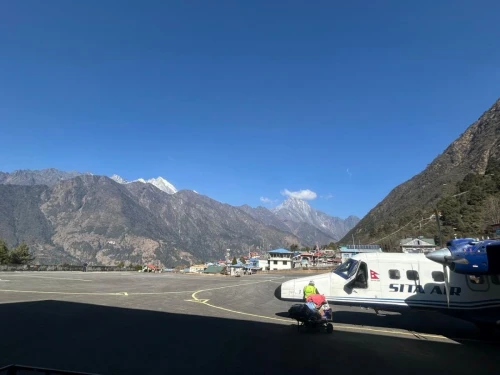Nepal is known for its rich culture and religious diversity, Hinduism is the dominant religion with 81.34% of the population, and Buddhism is the second most dominant religion with 9%. This makes Nepal the only Hindu-majority nation in the world, and it is home to many important Hindu temples, such as the famous UNESCO-listed Pashupatinath Temple in Kathmandu. Buddhism is also popular in Nepal, as it is the birthplace of Siddhartha Gautama Buddha in Lumbini, especially among ethnic groups such as the Sherpa, Tamang, and Newar. Mainly in the Terai region, 4.5 percent of the total population of Nepal follow Islam, while about 3 percent of the Kirat community follow tribal religion. Christianity is a minority religion comprising less than 2% of Nepal's population and has grown in recent years. Other religions, including Jainism and Sikhism, are the faiths of small communities.
Complete Details of Religion In Nepal
Table of Contents
Everest Base Camp Trek - 14 Days
Duration:14 DaysUS$1490US$1550Annapurna Base Camp Trek - 10 Days
Duration:10 DaysUS$550Everest Base Camp Trek With Helicopter Return
Duration:10 DaysUS$2090
Hinduism in Nepal
- Major Deities: Brahma, Vishnu, Shiva
- Scriptures: Vedas, Puranas,Vedangas
Hinduism is the most dominant religion in Nepal, with around 81% of the population identifying as Hindu, which is probably, the oldest religion in the world. According to Hinduism, everything in this universe is interconnected: so are our actions of the past life. Natural catastrophes are believed to be God's revenge. Referred to as the Santan dharma, Hinduism is said to have existed before human civilization.
Hinduism was established as the major festivals in Nepal like Dashain, Tihar, Gai Jatra, Holi, and Janai Purnima are celebrated throughout the nation with great enthusiasm and interest.
It is an ancient religion as there are about three hundred thirty million deities in the Hindu religion. Each deity is linked to an act or ceremony and has its importance. The Nepalese people choose the deities they worship daily in homes and temples, there is a tradition of worshipping a family deity (Kul devata) along with the other deities. The people worship the deities by offering sweets, flowers, and tika. They also chant, also known as bhajans representing specific gods to impress them.
Buddhism in Nepal
- Major Deities: Buddhas, Bodhisattvas
- Scriptures: Tripitaka
For second most dominant religion with 9% in Nepal. Buddhism isn’t just about beliefs; it is like a way to find peace inside and understand life better. In addition, you will find calm monasteries hidden in the hills, prayer flags swaying gently in the wind, and peaceful chants filling the valleys.
Moreover, Buddhism was first introduced in Nepal by Gautam Buddha during the rule of the 7th Kirat king Jitedasti. Siddhartha Gautam, the enlightened one, was born in Lumbini, Nepal, over two millennia ago.
Buddhism has two roots: Hinayana and Mahayana. Hinayana focuses on the teachings of the Buddha, and the Mahayana considers worshipping deities and archiving enlightenment by following them as examples.
Furthermore, traveling through Nepal’s valleys and mountains, you will discover a beautiful land of Buddhist traditions and practices. The Kathmandu valley, with its stunning stupas and pagodas, showcases Nepal’s rich Buddhist art and architectural heritage.
Islam
- Major Deities: Allah
- Scriptures: Quran
After Hinduism and Buddhism, Islam is the next most practiced faith constituting around 4 % of the total population of Nepal. The first time Islam religion in Nepal was during the 17th century by the northern Indians, and the first Muslims to enter Nepal can be 15th century when Kashmiri traders came to trade. Some Persians, Afghans, and Arabians worked as courtiers, counselors, and musicians of Nepali kings, traders, and manufacturers of guns, and also trained Nepali soldiers in the use of arms and ammunition.
Muslims mainly live in the Terai region close to India and cities like Kathmandu and Pokhara. In Nepal, Muslims celebrate massive festivals like Eid al-Fitr, known as Saghar Dawa or Ramadan Eid, which ends Ramadan with prayers, and gifts.
Christianity
- Major Deities: God, Jesus
- Scriptures: Bible
Christianity began in Nepal during the 18th century when European missionaries came to Nepal. but it was not until the middle of the 20th century that missionaries and Christian groups pushed it forward. The United Mission to Nepal (UMN), started in 1951 and helped set up the first Christian mission there, even though they faced many challenges from the law and society.
The Christian society celebrates Christmas and easter. During Christmas, which marks Jesus' birth, churches get all decked out with decorations, and people come together for prayers, and singing. Easter, when Jesus rose from the dead, is also a big deal.
Kiratism
- Major Deities: Shiva
- Scriptures: Kirat Mundhum
Kiratism is an ancient religion that is said to have originated in Nepal. the Kirat people are a native ethnic group living mainly in the eastern hills and mountain region of Nepal. The kiratism includes many castes like rai, sunwar, limbu, yakka, and others, each with its language and customs, contributing to Nepal’s cultural richness and diversity.
Kiratism focuses on nature and their ancestors' worship and is mentioned in the Hindu scriptures as devotees of lord Shiva. The board shiv has been known to take the Kirat form and is also worshipped as Kirateshowor Mahadev by both Hindus and Kirats.
Moreover, local legends and historical chronicles like ‘Kirat Rajya Laxmi,’ ‘Kirat Kulal,’ and ‘Yakshya Leela’ provide glimpses into the Kirat dynasty’s rule preceding the Licchavi dynasty in Nepal.
In addition to festivals, Kirat communities observe different customs for births, marriages, and funerals. The famous kirat festivals are chaite Dashain and celebrate festivals like Udhauli and Ubhauli marking the onset of the winter and summer seasons respectively and accordingly the migration of birds and animals to the warmer south or cooler northern regions.
Others
The other religious and unspecified which is around 0.7% of the Nepal population follow different religions like Jains, Sikhs, atheists, and Jews.
Sikhism is another such religion, about 7000 Sikhs reside in Nepal at present. In 1516 when guru Nanak visited Nepal, and spent a year meditating in the Balaju of Kathmandu. Many Sikhs also entered Nepal when they had a conflict with the East India Company in 1849. In the present time, there is a decent number of Sikhs in Nepal and they also have two gurudwaras.
Jainism is around 4000 Jains in Nepal who form the Jain society and worship in the Jain temple in Kathmandu. Jainism is probably an ancient religion in Nepal. The roots of Jainism in Nepal can be traced back to as early as 3000 BC when Bhadrabahu went to the country for penance and stayed there for twelve years preaching the teachings of Lord Mahavira.
What are the basic beliefs and practices of the major religions in Nepal?
The major religions Hinduism, Buddhism, Islam, Kirat, and Christianity have beliefs and practices in Nepal. Hinduism, the largest and ancient religion, is based on the belief in a supreme reality and emphasizes thoughts like dharma, karma, and samsara, with the ultimate goal being moksha. Hindus practice daily prayers, worship in temples, sing the Vajan, and celebrate festivals like Dashain and Tihar.
Buddhism focuses on the four Nobel truths, the Eightfold Path, meditation, mindfulness, and ethical living. Islam emphasizes the five pillars: faith, prayer, charity, fasting during Ramadan, and pilgrimage to Mecca, with daily prayers and community worship being key practices. Christianity, although a smaller faith in Nepal, is based on the belief in one God, reading the Bible, with practices including prayer in church, and celebrating Christmas.
The practices of religion may include rituals, sermons, commemoration, or veneration of a deity (God or goddess), sacrifices, festivals, feasts, trances, initiations, funerary, services, meditation, prayer, religious music, religious art, sacred dance, public service, or other human culture.
What was a major religion of ancient China that the Nepali believed in karma and nirvana?
A major religion of ancient China that aligns with Nepali beliefs in karma and nirvana is Buddhism.
It originated in India in the 6th century BCE and spread to many parts of Asia, including China and Nepal. it teaches the concepts of karma (The law of cause and effect) and nirvana (The cycle of rebirth and suffering). These beliefs became central to many Buddhist schools in China, such as Chan (Zen) and Pure Land Buddhism. They were shared across Buddhist communities in Nepal, where Buddhism has been practiced alongside Hinduism for centuries.


 4 reviews
4 reviews
.webp)



